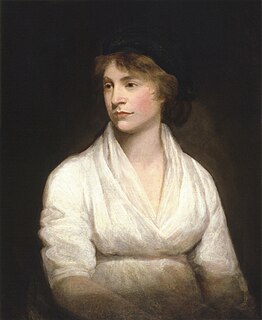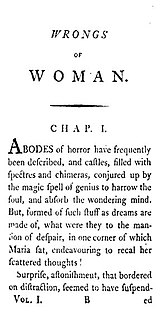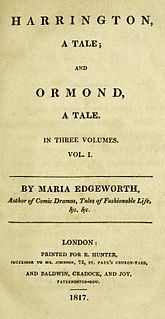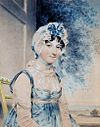
A Vindication of the Rights of Woman: with Strictures on Political and Moral Subjects (1792), written by the 18th-century British proto-feminist Mary Wollstonecraft, is one of the earliest works of feminist philosophy. In it, Wollstonecraft responds to those educational and political theorists of the 18th century who believed that women should not receive a rational education. She argues that women's education ought to match their position in society, and that they are essential to the nation because they raise the children and could act as respected "companions" to their husbands. Wollstonecraft maintains that women are human beings deserving of the same fundamental rights as men, and that treating them as mere ornaments or property for men undercuts the moral foundation of society.

Mary Wollstonecraft was an English writer, philosopher, and advocate of women's rights. Until the late 20th century, Wollstonecraft's life, which encompassed several unconventional personal relationships at the time, received more attention than her writing. Today Wollstonecraft is regarded as one of the founding feminist philosophers, and feminists often cite both her life and her works as important influences.

Sense and Sensibility is a novel by Jane Austen, published in 1811. It was published anonymously; By A Lady appears on the title page where the author's name might have been. It tells the story of the Dashwood sisters, Elinor and Marianne as they come of age. They have an older half-brother, John, and a younger sister, Margaret.

Maria Edgeworth was a prolific Anglo-Irish writer of adults' and children's literature. She was one of the first realist writers in children's literature and was a significant figure in the evolution of the novel in Europe. She held views on estate management, politics and education, and corresponded with some of the leading literary and economic writers, including Sir Walter Scott and David Ricardo.

Castle Rackrent is a short novel by Maria Edgeworth published in 1800. Unlike many of her other novels, which were heavily "edited" by her father, Richard Lovell Edgeworth, before their publication, the published version is close to her original intention.
The Absentee is a novel by Maria Edgeworth, published in 1812 in Tales of Fashionable Life, that expresses the systemic evils of the absentee landlord class of Anglo-Irish and the desperate condition of the Irish peasantry. There are many turns of plot and much information about Ireland as well as Irish dialect and details of shallow London fashionable life, and the egregious results of the propertied classes treating their Irish lands as a resource to be exploited rather than as a relationship among classes and with the land. In this respect, it addresses similar themes to her first novel, Castle Rackrent.

Charlotte Smith, an English novelist and poet of the Romantic period, prompted a revival of the English sonnet, helped to set conventions for Gothic fiction and wrote political novels of sensibility. Despite ten novels, four children's books and other works, she saw herself mainly as a poet, expecting to be remembered for her Elegiac Sonnets. She is credited with turning the sonnet into an expression of woeful sentiment. She left her husband and began writing to support their children. Her struggles for legal independence as a woman affect her poetry, novels and autobiographical prefaces. Her early novels show development in sentimentality. Later ones such as Desmond and The Old Manor House praised the ideals of the French Revolution. Waning interest left her destitute by 1803. Barely able to hold a pen, she sold her book collection to pay debts and died in 1806. Largely forgotten by the mid-19th century, she has since been seen as a major Romantic writer.

Evelina, or the History of a Young Lady's Entrance into the World is a novel written by English author Fanny Burney and first published in 1778. Although published anonymously, its authorship was revealed by the poet George Huddesford in what Burney called a "vile poem".

Sydney, Lady Morgan, was an Irish novelist, best known for The Wild Irish Girl (1806), a romantic, and some critics suggest, "proto-feminist", novel with political and patriotic overtones. Her work, including continental travelogues, sparked controversy and faced censorship. She counted Percy Bysshe Shelley and by Lord Byron among her defenders.

Sensibility refers to an acute perception of or responsiveness toward something, such as the emotions of another. This concept emerged in eighteenth-century Britain, and was closely associated with studies of sense perception as the means through which knowledge is gathered. It also became associated with sentimental moral philosophy.
The sentimental novel or the novel of sensibility is an 18th-century literary genre which celebrates the emotional and intellectual concepts of sentiment, sentimentalism, and sensibility. Sentimentalism, which is to be distinguished from sensibility, was a fashion in both poetry and prose fiction beginning in the eighteenth century in reaction to the rationalism of the Augustan Age.

Mary: A Fiction is the only complete novel by 18th-century British feminist Mary Wollstonecraft. It tells the tragic story of a female's successive "romantic friendships" with a woman and a man. Composed while Wollstonecraft was a governess in Ireland, the novel was published in 1788 shortly after her summary dismissal and her decision to embark on a writing career, a precarious and disreputable profession for women in 18th-century Britain.

General Sir Charles Asgill, 2nd Baronet, was a career soldier in the British Army. Asgill enjoyed a long military career, eventually rising to the rank of general. He is best remembered as the principal of the so-called Asgill Affair of 1782, in which his retaliatory execution while a prisoner of war was commuted by the American forces who held him, due to the direct intervention of the government of France. Later in his career, he was involved in the suppression of the Irish Rebellion of 1798 and was Commander of the Eastern Division of Ireland during the Irish rebellion of 1803.

Maria: or, The Wrongs of Woman is the 18th-century British feminist Mary Wollstonecraft's unfinished novelistic sequel to her revolutionary political treatise A Vindication of the Rights of Woman (1792). The Wrongs of Woman was published posthumously in 1798 by her husband, William Godwin, and is often considered her most radical feminist work.
Belinda is an 1801 novel by the Anglo-Irish writer Maria Edgeworth. It was first published in three volumes by Joseph Johnson of London. The novel was Edgeworth's second published, and was considered controversial in its day for its depiction of an interracial marriage. It was reprinted by Pandora Press in 1986.
The Castle of Wolfenbach (1793) is the most famous novel written by the English Gothic novelist Eliza Parsons. First published in two volumes in 1793, it is among the seven "horrid novels" recommended by the character Isabella Thorpe in Jane Austen's novel Northanger Abbey and an important early work in the genre, predating Ann Radcliffe's The Mysteries of Udolpho and Monk Lewis's The Monk.
Dear creature! How much I am obliged to you; and when you have finished Udolpho, we will read The Italian together; and I have made out a list of ten or twelve more of the same kind for you.
Have you, indeed! How glad I am! What are they all?
I will read you their names directly; here they are, in my pocketbook. Castle of Wolfenbach, Clermont, Mysterious Warnings, Necromancer of the Black Forest, Midnight Bell, Orphan of the Rhine, and Horrid Mysteries. Those will last us some time.
Yes, pretty well; but are they all horrid, are you sure they are all horrid?

Harrington is an 1817 novel by British novelist Maria Edgeworth. The novel was written in response to a letter from a Jewish-American reader who complained about Edgeworth's stereotypically anti-semitic portrayals of Jews in Castle Rackrent (1800), Belinda (1801), The Absentee (1812), and her Moral Tales (1801) for children. The novel is an autobiography of a "recovering anti-Semite", whose youthful prejudices are undone by contact with various Jewish characters, particularly a young woman. It also makes parallels between the religious discrimination of the Jews and the Catholics in Ireland. Set between the Jewish Naturalization Act of 1753 and the Gordon Riots of 1780, the timeframe highlights these connections.

Patronage is a four volume fictional work by Anglo-Irish writer Maria Edgeworth and published in 1814. It is one of her later books, after such successes as Castle Rackrent (1800), Belinda (1801), Leonora (1806) and The Absentee in 1812, to name a few. The novel is a long and ambitious one which she began writing in 1809. It is the longest of her novels.

A Simple Story is a novel by English author and actress, Elizabeth Inchbald. Published in early 1791 as an early example of a "novel of passion", it was very successful and became widely read in England and abroad. It went into a second edition in March 1791. It is still in print today.

Honora Edgeworth was an eighteenth-century English writer, mainly known for her associations with literary figures of the day particularly Anna Seward and the Lunar Society, and for her work on children's education. Sneyd was born in Bath in 1751, and following the death of her mother in 1756 was raised by Canon Thomas Seward and his wife Elizabeth in Lichfield, Staffordshire until she returned to her father's house in 1771. There, she formed a close friendship with their daughter, Anna Seward. Having had a romantic engagement to John André and having declined the hand of Thomas Day, she married Richard Edgeworth as his second wife in 1773, living on the family estate in Ireland till 1776. There she helped raise his children from his first marriage, including Maria Edgeworth, and two children of her own. Returning to England she fell ill with tuberculosis, which was incurable, dying at Weston in Staffordshire in 1780. She is the subject of a number of Anna Seward's poems, and with her husband developed concepts of childhood education, resulting in a series of books, such as Practical Education, based on her observations of the Edgeworth children. She is known for her stand on women's rights through her vigorous rejection of the proposal by Day, in which she outlined her views on equality in marriage.

















